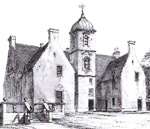The Merchant Guildry of Stirling started officially in 1226 when King Alexander II granted a Charter to the Merchant Guild or Guildry in the town. There had been for an over a hundred years previous to 1226 an Association of men of commerce and this attributed to King David I and his laws for the four Burghs of Edinburgh, Roxburgh, Berwick and Stirling.
These early Charters were confirmed in the year 1360 by King David II who was the son of Robert the Bruce and four years later at Perth he granted a National Charter which was regarded by Merchant Burgesses of all Royal Burghs as the foundation of their trading rights.
In 1678 when King Charles II granted the last of the great Charters to the Burgh of Stirling the charter confirmed the rights and privileges in the Charter previously granted by his Royal Father some 37 years earlier.
In the past the whole trading community was covered by the Guildry and it guarded the interest of the merchants throughout the centuries, The Guildry and Town Council were accepted as synonymous until in the Act of 1846 trading privileges were abolished. Since then the Guildry has maintained an interest in the affairs of the Royal Burgh and has continued to appear in public at certain occasions.
In 1360, King David II, who was the son of Robert the Bruce, gave as a personal gift to the Guildry of Stirling the Guildry Ring. This was the symbol of the investiture of the Charter. The ring weighs half an ounce; is set with five jewels arranged in the form of a cross and is intended to be worn on the thumb or large finger. It is of greater age than both the East and West parts of the Church of the Holy Rude. It is older than Stirling’s four span stone bridge built in the reign of Robert III between 1390 and 1408.
 The emblem or symbol of the Guildry of Stirling is a reversed figure four in a floral design. The Burgh building has a large replica of the symbol carved in stone, and it is seen also in the Guildhall.
The emblem or symbol of the Guildry of Stirling is a reversed figure four in a floral design. The Burgh building has a large replica of the symbol carved in stone, and it is seen also in the Guildhall.
For centuries the story of the Guildry was the story of Stirling, its members dominated the Town Council and the Kirk Session as well as the entire commerce of the town.
Due to legislation and changes in trading and the need to provide equal opportunities for all and the emancipation of all its workers. The Guildry fades away from trade, commerce and politics, but with the disappearance of the Royal Burgh in 1975 the Guildry and Dean’s Council felt compelled to continue to further some of the old traditions of the town. The Guild of Brethren are determined to preserve some of the traditions of its forbears and of the great Royal Burgh of Stirling one of the first Royal Burghs of Scotland.
